Answered step by step
Verified Expert Solution
Question
1 Approved Answer
Graph Shen is a post doctoral fellow who teaches particle physics at a university where he earns an annual salary of $200,000. He intends to


Graph
Shen is a post doctoral fellow who teaches particle physics at a university where he earns an annual salary of $200,000. He intends to take the next year off to focus on writing a new undergraduate physics textbook, so he will not earn any income next year. He is currently deciding how much of this year's salary he should save for next year. Assume that there are no tax implications associated with the decision, and ignore what happens after next year. Therefore, next year Shen will consume whatever he saves this year plus interest, and he is not concerned with the future beyond next year. The following graph shows Shen's preferences for consumption this year and next year. Suppose initially Shen cannot earn interest on the money he saves. Use the green fine (triangle symbol) to plot Shen's budget constraint ( BC1 ) on the following graph. Then use the black point ( p lus symbol) to show his optimum consumption bundle. Note: Dashed drop lines will automatically extend to both axes. Now suppose Shen can earn 20% real interest on any money he saves. Use the blue line (circle symbol) to plot his new budget constraint (BC B2 ) on the previous graph. Then use the grey point (star symbol) to plot his optimum consumption bundle at this interest rate. (Hint: To plot BC. think about how much money Shen would have next year ir he saved his entire income this year.) Using the previous graph, complete the following table by indicating how much Shen should save of his current income when he cannot earn any interest on his savings and when he can eam 20% interest on his savings. Which of the following statements is a good description of the results of this exercise, as well as its implications for broader consumer behavior? All consumers, including Shen, save less money when interest rates are high, because they don't need to save as much money to have the same future income. In this case, Shen saves less money when interest rates are high. However, consumers with different preferences might save more money when interest rates are high. In this case, Shen saves more money when interest rates are high. However, consumers with different preferences might save less money when interest rates are high. All consumers, including Shen, save more money when interest rates are high, because they get a higher return on that investmentStep by Step Solution
There are 3 Steps involved in it
Step: 1

Get Instant Access to Expert-Tailored Solutions
See step-by-step solutions with expert insights and AI powered tools for academic success
Step: 2

Step: 3

Ace Your Homework with AI
Get the answers you need in no time with our AI-driven, step-by-step assistance
Get Started


